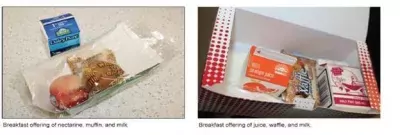School Lunches During COVID-19
What happens to children who rely on meals at school when the coronavirus pandemic results in unexpected school closures?
Federal nutrition assistance programs are usually used to provide food to children in low-income areas when schools are closed for vacation. However, they can also operate during natural disasters or other emergencies when schools have to close unexpectedly.
One such program is the Summer Food Service Program. We’ve looked into how this program can serve children when school is not session—and the challenges it faces in doing so.
Today’s WatchBlog explores.
The Summer Food Service Program
USDA’s Summer Food Service Program, which serves both urban and rural areas, generally provides free meals to children age 18 and under in low-income areas when schools are closed. Pictured below are some examples of meals served under the Summer Food Service Program.
Normally, these meals must be served to children in a group setting, and children must eat these meals on site (at locations like schools, parks, and libraries). However, USDA can grant states the flexibility to provide meals to children outside of a group setting when safety is a concern, such as during the coronavirus epidemic.
In fact, USDA announced that all states, the District of Columbia, and territories have received approvals enabling them to serve meals to children in non-group settings during school closures related to COVID-19 through the Summer Food Service Program and the National School Lunch Program Seamless Summer Option.
Program challenges
As we reported in 2018, the Summer Food Service Program served 149 million meals to children in low-income areas nationwide in FY 2016—up from 113 million in FY 2007.
USDA uses the number of meals served (along with other data) to estimate the number of children participating in this program. However, we found that the program’s participation estimates were calculated inconsistently from state to state and year to year—hurting USDA’s ability to use this information for planning purposes.
Some states also reported a challenge with ensuring meal sites are in safe locations. To address this issue, USDA granted some states flexibility from the requirement that children consume meals on site. However, USDA had not clearly communicated the kinds of circumstances that would warrant this flexibility. Some states who requested this flexibility also reported difficulty obtaining the data to show these circumstances exist.
A way forward
As the nation responds to the pandemic, it will be important for USDA to calculate reliable participation estimates to help assess whether meals are reaching those in need. We made 4 recommendations to help address these and other issues—including that USDA improve estimates of participation in the Summer Food Service Program. We also recommended that USDA better communicate the circumstances it considers when granting flexibilities to ensure safe meal delivery.
Other federal programs that can help or have helped provide meals or nutrition assistance benefits while schools are out include:
· The Seamless Summer Option of the National School Lunch Program
· The Summer Electronic Benefit Transfer for Children
· Special Supplemental Nutrition Program for Women, Infants, and Children (WIC)
· Child and Adult Care Food Program (CACFP)
· The Supplemental Nutrition Assistance Program (SNAP)
To learn more, check out our report and listen to our podcast.
Comments on GAO’s WatchBlog? Contact blog@gao.gov.
GAO Contacts
Related Products

GAO's mission is to provide Congress with fact-based, nonpartisan information that can help improve federal government performance and ensure accountability for the benefit of the American people. GAO launched its WatchBlog in January, 2014, as part of its continuing effort to reach its audiences—Congress and the American people—where they are currently looking for information.
The blog format allows GAO to provide a little more context about its work than it can offer on its other social media platforms. Posts will tie GAO work to current events and the news; show how GAO’s work is affecting agencies or legislation; highlight reports, testimonies, and issue areas where GAO does work; and provide information about GAO itself, among other things.
Please send any feedback on GAO's WatchBlog to blog@gao.gov.





